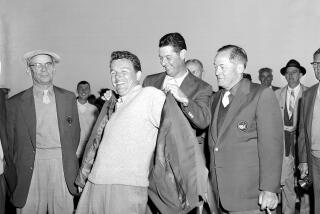The Spirit Of St. Andrews
“St. Andrews? I feel like I’m back visiting an old grandmother. She’s crotchety and eccentric but also elegant. Anyone who doesn’t fall in love with her has no imagination.”
--TONY LEMA, 1964 British Open winner at St. Andrews
For the record:
12:00 a.m. July 28, 2000 For the Record
Los Angeles Times Friday July 28, 2000 Home Edition Sports Part D Page 5 Sports Desk 1 inches; 16 words Type of Material: Correction
Golf-- Royal St. George’s Golf Course is in Sandwich, England. Its location was incorrectly reported July 20.
*
On first glimpse every golfer has his or her own take on the Old Course at St. Andrews. Many are enamored of the bumpy linksland and the “Grey Auld Toon” watching ominously over the 18th green. Some, usually American tourists fresh from experiencing links golf for the first time, tend to question what all the Old Course hype is about. While others refuse to believe it is even a golf course.
“The grass was all scroggly and the greens looked like they weren’t maintained, and the bunkers looked like they had never been raked,” Sam Snead said after seeing the Old Course on the train ride into town. “And I asked the gentleman sitting across from me, ‘What old abandoned golf course is that?’ And the gentleman took off his hat and stood up with a horrified look on his face and said, ‘I’ll have you know that’s the Royal and Ancient Golf Club of St. Andrews!’ ”
That was 1946 and Snead went on to win the British Open a week later, his first and only Open appearance. And like so many others, Snead also became an admirer of the Old Course, although he couldn’t resist one more wry observation: “Until you play it, St. Andrews looks like the sort of real estate you couldn’t give away.”
What is it about this 90 acres of quirky contours, waterways called burns, double greens, blind bunkers with names and road holes? After all, this 500-year-old links has no significant elevation change, wasn’t envisioned by a “signature” architect and it’s devoid of trees. So does nostalgia keep the Old Course in the British Open rotation? Or does it remain golf’s ultimate natural experience and the world’s finest test of creativity, judgment and shotmaking?
“Nowhere in the world is golf so little cut and dried,” wrote famed writer and amateur golfer Bernard Darwin. “It is a course of constant risks and constant opportunities of recovering, of infinitely varied and, to the stranger, unorthodox shots.”
The Old Course had no actual architect, instead evolving naturally over several hundred years with an occasional assist from man. Its playability for all golfers along with the unforced naturalness of its architecture is why master architect Alister MacKenzie agreed to spend a year mapping it and why most other designers still believe the Old Course is the ultimate in golf architecture.
“I believe the real reason St. Andrews’ Old Course is infinitely superior to anything else is owing to the fact that it was constructed when no one knew anything about the subject at all,” MacKenzie wrote in his 1934 manuscript, “The Spirit of St. Andrews.” “And since then it has been considered too sacred to be touched. I doubt if even in a hundred years’ time a course will be made which has such interesting strategic problems and which creates such enduring and pleasurable excitement.”
The game was played at St. Andrews as early as 1362, but genuinely evolved in the mid-to-late 1400s when Dutch sailors would dock offshore, then belt pebbles with crudely crafted sticks as they made the trek into town amid the heather, whin bushes and dunes. Counting as they went, the game became too hard to keep track of, so they cut holes along the way and kept score going into town and on the way back out. The townspeople took to the game as well, and golf was born. Though not officially until 1552, after a royal ban forbidding golf had been lifted.
From the outset St. Andrews was a 22-hole course, starting up the hill behind the current clubhouse site and meandering down into the seaside flats amid the dense gorse and rolling linksland. But the course was crowded and unsafe because players used the same holes going out as they did coming in. By the mid-1700s St. Andrews was down to 18 holes, a total that became the standard for all future golf courses.
By the mid-1800s St. Andrews began to take on the look we see today, thanks in part to a Royal and Ancient Golf Club’s 25-pound investment in course improvements. Greens were expanded so that players would not fight over the same hole. Wider fairways were created by removing brush, revealing tempestuous contours. Bunkers were either built to replace clumps of heather, or more commonly, when sheep would burrow into the dunes for protection during inclement weather. These changes, coupled with the sandy soil and the rabbit-mown fescue turf, created firm and fast conditions that came to be known as links golf.
The Old Course continued to evolve over the next couple of centuries with the help of wind, water and local golf great Old Tom Morris, who also served as “Custodian of the Links.” Old Tom made modifications to the design until his retirement in 1903, but not since a small pot bunker was covered over in 1949 has the Old Course design been altered. Substantial length was added in recent years on virtually every hole to ensure that the playing strategy remained undiminished in the face of improved technology and stronger players. For this year’s Open the par fours at 15 and 16 will each play 40 yards longer and 120 yards have been added to six other holes since John Daly’s 1995 Open win. The course will play to 7,115 yards, the first time in its history it has exceeded 7,000 yards. But the spirit and subtlety of the Old Course remains unchanged.
How does a peculiar-looking layout with 112 randomly placed bunkers, shared fairways, seven double greens and numerous blind shots reward championship-caliber golf? Isn’t a winner at the Old Course merely the best wind player and the least unlucky golfer over four days?
“Commentators frequently remark that luck or ‘rub of the green’ plays an especially significant role at St. Andrews. I disagree,” says Nick Faldo, winner of the 1990 British Open played over the Old Course. “If a ‘good straight drive up the middle’ finds a ‘nasty hidden little pot bunker,’ then clearly the drive shouldn’t have been aimed toward the middle of the fairway. This puzzles some people, but golf would surely be a monotonous game if the center of the fairway was always the optimum line, and at St. Andrews it usually isn’t. I believe one of the Old Course’s greatest qualities is its capacity to sift good shots from those that have been poorly conceived.”
The Old Course requires boundless creativity, local knowledge and adapting to the ever-changing wind. No matter how bizarre the conditions get, the option to attack each hole from multiple angles makes St. Andrews playable for all golfers but also a constant decision-making test for the elite player. No other layout requires as much thought or shotmaking skill, a distinctive combination not prevalent in many modern golf courses.
Adapting to constantly changing conditions and cruel bounces has always been the biggest obstacle to winning at St. Andrews. Unlike many of his fellow modern professionals, Tiger Woods has developed a fascination with the Old Course after only a few tournament rounds. Woods cites St. Andrews’ room for shotmaking creativity and the need for adapting to changing conditions as being the most ideal test of golf.
“It’s amazing how different the wind can be at St. Andrews,” Woods said with a fascinated smile immediately after winning the U.S. Open by 15 strokes last month. “On the first hole at the 1998 Dunhill Cup matches there, I hit a two-iron and a sand wedge one day, a driver and four-iron the next day. And there are bunkers there that you never see until the wind changes; I’m amazed at the genius involved in designing a course like that.”
The opening hole starts immediately below the 200-year-old clubhouse and is an excellent opener playing to a wide fairway bisected by a road named Granny Clark’s Wynd. The large first green is perched on the bank of Swilcan Burn, and it’s the only time water comes into play at St. Andrews.
In terms of textbook architecture, however, things get a bit peculiar after the famed first. Not many architects could get away with designing six straight holes heading northwest, as holes two through seven do. Even more unconventional is that those six holes have numerous blind bunkers, out-of-bounds to the right on each and quirky mounding in the landing areas. Yet each has its own distinctive strategy.
After the relatively normal forced-carry par-three eighth, two drivable par fours at nine and 10 await. They play in a northeast direction at the farthest point from the clubhouse and each can be driven under certain wind conditions. The much-copied par-three 11th then crosses, yes, crosses back over the par-four seventh fairway where those two holes share a green perched above the Eden River Bay. From there in, holes 12 through 17 play in a virtual line toward the southeast. And like the front nine, each has out-of-bounds down the right side.
At the 461-yard par-four 17th, the players face numerous temptations and looming disasters on the infamous “Road Hole,” where the tee shot must carry a wooden shed and play to a green perched precariously above an old road. The course makes a final left turn with the 354-yard, bunkerless par-four 18th. As a finishing hole on any other course it would be a letdown. However, playing against the backdrop of medieval buildings to a green guarded by the “Valley of Sin,” the “Home” hole may be the greatest stage in all of golf.
“I do not get cross anymore when young golfers claim they detest the place,” said three-time Open winner Henry Cotton. “I just feel sorry they are so ignorant and unappreciative of what they have inherited--but I am sure most of these, as they grow older, learn to understand that golf is a dull game when every hole plays the same way every day. At St. Andrews you never know what to expect.”
*
Geoff Shackelford is the author of several books including The Golden Age of Golf Design.
(BEGIN TEXT OF INFOBOX / INFOGRAPHIC)
British Open Courses
Number of times courses have been used for the British Open (with last year used):
26: St. Andrews, Scotland (2000)
24: Prestwick, Scotland (1925)
14: Muirfield, Scotland (1992)
12: Royal St. George’s, Scotland (1993)
10: Hoylake, England (1967)
9: Royal Lytham & St. Anne’s, England (1996)
8: Royal Birkdale, England (1998)
7: Royal Troon, Scotland (1997)
6: Musselburgh, Scotland (1889)
6: Carnoustie, Scotland (1999)
3: Turnberry, Scotland (1994)
2: Deal, England (1920)
1: Prince’s, England (1932)
1: Portrush, Ireland (1951)
More to Read
Sign up for The Wild
We’ll help you find the best places to hike, bike and run, as well as the perfect silent spots for meditation and yoga.
You may occasionally receive promotional content from the Los Angeles Times.






